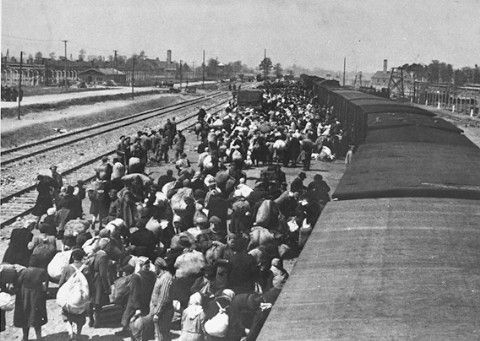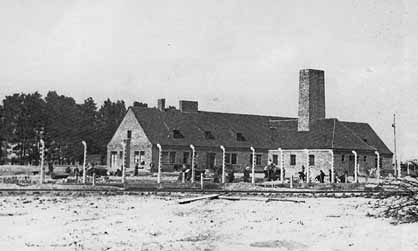The Deportation of the
Hungarian Jews
 Irene Zisblatt, a survivor of
Auschwitz-Birkenau
Irene Zisblatt, a survivor of
Auschwitz-Birkenau
The photo above shows Irene Zisblatt, a Hungarian Holocaust survivor
who now lives in Florida, as she addressed students from Fairland
High School in 2009, telling them about her experience at Auschwitz-Birkenau
and other Nazi concentration camps. She is pointing to the spot
under her arm where her prison number tattoo was removed in an
experiment by Dr. Josef
Mengele at Birkenau.
Irene makes frequent talks to American
students. A video tape of her talk to students at Huntington
High School can be seen on this website.
Irene Zisblatt wrote a book, published
in 2008, entitled "The Fifth Diamond" about her time
in the Birkenau camp. The title refers to a necklace with four
diamonds, set into a pendant, that she wears around her neck
when she speaks to American school children who are studying
the Holocaust. As a survivor, Irene is the Fifth Diamond. Gail
Ann Webb, a school teacher, helped Irene write the book, which
is concise and especially suitable for students who are studying
the Holocaust in middle school.
For 50 years, Irene kept quiet about
her ordeal in the Nazi concentration camps, but in 1994, after
Steven Spielberg's movie "Schindler's List" came out,
she decided to tell her story. In 1995, she was interviewed for
3 hours by Jennifer Resnick while her testimony was videotaped
for Spielberg's Shoah Foundation. She was then chosen as one
of five Hungarian survivors to be featured in Spielberg's Academy
Award winning documentary entitled "The Last Days,"
which was released in 1998. A book, also entitled "The Last
Days," was published in 1999.
In the documentary "The Last Days,"
Irene tells about how her mother gave her the diamonds before
the family was sent to the Auschwitz death camp. She managed
to keep them through all the time that she was in the concentrations
camps, and on a death march out of a camp, by swallowing them
before being searched, excreting them, cleaning them and then
swallowing them again. She sometimes cleaned her diamonds "in
the soup we were going to get."
In "The Last Days," Irene said
that she "was about 9 years old" when she was expelled
from school in 1939. A curfew was established and "Jewish
people were forbidden to leave their houses after six in the
evening or before eight in the morning." Irene's father
lost his business when it was given to a Gentile. Hungary was
allies with Germany, and according to Irene: "We didn't
see a Nazi in our home town until 1944; everything had been done
by the Hungarian police and by local youths under Nazi orders."
Irene had lived with her family in the
small resort town of Polena in the Carpathian mountains; at that
time, Polena was in Hungary. There were 62 Jewish families in
the town; her father owned a business, but they had no electricity
in their house, according to Irene. This was not unusual in those
days; many towns in Eastern Europe had no running water and no
electricity.
After Germany invaded Hungary on March
19, 1944, Irene and her family were put into the Miskolc ghetto,
which Irene said "consisted of a couple of streets around
a brick factory." All the houses "were already crammed
full" so Irene and her family "built a little tent
from our tablecloths and sheets, whatever we had in our suitcases,
and we lived under that."
Irene tells students that she was 13
years old when she was put on a train from the Miskolc ghetto
to the Auschwitz-Birkenau death camp during the deportation of
the Hungarian Jews in May 1944. She was immediately separated
from her family and she was the only one of her 40 family members
to survive the gas chambers. According to her story in the book
entitled "The Last Days," Irene's father was born in
1908, so he was 36 years old in 1944, young enough to be selected
for work at Birkenau. In the selections upon arrival at Birkenau,
everyone older than 45 or younger than 15 was sent immediately
to the gas chamber. Irene says that her entire family was gassed
in Gas Chamber #2 on the day that they arrived, including her
parents who were of working age.
Irene says that the Jews in the Miskolc
ghetto were tricked into getting on the train to Birkenau. "The
train came in the night and it was announced that everybody who
wanted to go to Tokaj to work in the vineyards should get on
the train."
In the book "The Last Days,"
Irene tells how her mother gave her advice, before the train
left the ghetto, that saved her from being immediately selected
for the gas chamber at Birkenau.
The following quote is from the book
entitled "The Last Days":
And she told me to say I was twenty
years old - I was only thirteen - because then I would be sent
to work in a factory where I would get food and I would survive.
The following quote is from a newspaper
article
written by Nate Hubbard after Zisblatt gave a talk to students
in Bland County, Virginia on March 9, 2009:
But the most gripping part of Zisblatt's
account came when she told of narrowly escaping the gas chamber.
She said she was selected along with approximately 1,500 other
women to be killed. When the prisoners were herded into the gas
chamber, though, there wasn't room for them all. Zisblatt said
she wound up right in the doorway, clinging to a piece of wood
as her fingernails were ripped off causing blood to gush from
the tips of her fingers. When the door couldn't be closed with
Zisblatt blocking the way, she was flung out of the chamber.
With the help of another prisoner,
she said she was able to escape Auschwitz by getting on a train
traveling across tracks running near the No. 3 gas chamber. The
train took her to the Neuengamme labor camp in Germany where
shortly after she was forced to go on a "death march"
as the war wound down. After marching for days upon days in hellacious
conditions, Zisblatt said she and a friend realized they had
a chance to escape during a dark night as they stood between
two forests. [...] Providence, though, finally smiled down on
Zisblatt as she and her friend made a successful escape and were
soon thereafter discovered by American soldiers.
Irene Zisblatt had been saved by a young
Sonderkommando (Jewish crematorium worker) who rescued her after
she was thrown out of the Krema
III gas chamber because the room was too full. He wrapped
her in a blanket and tossed her over the 10-foot-high barbed
wire fence around Krema III; she landed in an open railroad car
of a train that was bound for the Neuengamme concentration camp in Germany.
The photo below, from the Auschwitz Album,
a series of photos taken by the Germans on May 26, 1944, shows
a freight train on a side track on the right hand side. Krema
III is on the right, about one inch from the edge of the photo;
it is the building with a high chimney. On the left side of the
photo, Krema II with its high chimney can be seen.
 Transport trains brought
Hungarian Jews very close to the gas chambers
Transport trains brought
Hungarian Jews very close to the gas chambers
 Crematorium III at
Birkenau, as it looked in 1943
Crematorium III at
Birkenau, as it looked in 1943
In May 1944, the railroad tracks at Auschwitz
had been extended from the Auschwitz station into the Birkenau
camp so that the trains carrying the Hungarian Jews could be
brought right up to the gas chambers. The old photo above shows
the railroad tracks a few feet from the 10-foot-high barbed wire
fence around Krema III.
Remarkably, Irene Zisblatt was not the
only Holocaust survivor to escape from an Auschwitz gas chamber.
The story of Gena Goldfinger Turgel is told in a 2005 news article
on the web site of the Daily Mail in the UK. In
December 1944, Gena arrived at Auschwitz-Birkenau after having
walked all the way from the Plaszow concentration camp near Cracow.
The following quote is from the story
in the Daily Mail:
Gena Turgel entered the gas chamber
at Auschwitz and lived to tell the tale.
In the winter of 1944, the 21-year-old
was made to strip naked with her mother inside the concentration
camp's extermination block and wait, but miraculously the deadly
poison was never released.
Alice Lok Cahana, whose story was recounted
by Laurence Rees in his book entitled "Auschwitz, a New
History" was 15 years old when she was registered in the
Auschwitz-Birkenau camp; months later she was sent to the gas
chamber in Krema V and told that she would be given new clothes
after taking a shower. Alice was inside the gas chamber in Krema
V when the revolt by the Sonderkommando unit in Krema IV began
on October 7, 1944. This was the occasion when the Sonderkommando
blew up the Krema IV gas chamber building with dynamite that
had been sneaked into Birkenau by some of the women prisoners
who worked in factories outside the camp. Because of all the
commotion, the women in the Krema V gas chamber were released
unharmed.
Alice Lok Cahana is also featured in
Steven Spielberg's documentary "The Last Days" and
in the book that accompanies the film, which was published in
1999.
In a talk to a class of West Virginia
high school students, Irene Zisblatt said that she was one of
the prisoners chosen for Dr. Mengele's medical experiments. Zisblatt
said "Mengele was trying to change the color of our eyes.
So he injected our eyes and put us in a dungeon in the dark.
And then when we come out 3 out of the 5 were blind. And in the
dark we were there for about five days in the dungeon, we were
standing in water."
According to a news story about the talk that Irene Zisblatt
gave to students in West Virginia: "She would emerge with
her eyesight, but she still had green eyes instead of the blue
that Josef Mengele had hoped for."
Dr. Joseph Mengele also selected Zisblatt
for another experiment in which he removed the tattoo from her
arm without an anesthetic. Jews at Auschwitz were branded with
a number tattooed on their arms which corresponded with their
identification number on an IBM Hollerith punch card which was
used to track them. According to Zisblatt, Dr. Mengele was experimenting
on ways that the SS men could remove the blood type tattoos
under their arms after the war, so that they could deny that
they were ever in the SS. Dr. Mengele was in the SS, but he did
not have this kind of tattoo. After the war, the Allies declared
the SS to be a criminal organization which meant that every SS
man was a war criminal.
In a video taped interview, Zisblatt
told about the removal of her tattoo and about being selected
for an inspection by Ilse Koch who was looking for "unblemished
skin" in order to make leather lampshades. Ilse Koch was the infamous wife of Karl Otto
Koch, the Commandant of Buchenwald. Zisblatt and several other
girls were sent on a train to the Majdanek camp in Lublin where Ilse Koch was
expected to arrive, but she never made it.
Some of the Buchenwald prisoners had
told about Ilse making lampshades out of human skin and she was
put on trial by Nazi judge Dr. Georg Konrad Morgen in December
1943. Although Ilse was acquitted of all charges, she was kept
in prison in Weimar until December 1944, according to the book
entitled "Die Hexe von Buchenwald." The next day, after
Ilse Koch failed to show up, Zisblatt and the other girls returned
to Auschwitz-Birkenau.
Zisblatt works with the Holland & Knight Law Charitable Foundation
as a judge in selecting the winning essays for their national
Holocaust Remembrance Project's annual contest for High School
students.
Another Hungarian Holocaust survivor
is Ebi Gabor who was 17 years old when she was sent to Auschwitz-Birkenau.
Ebi wrote the story of her time in the camp in a book entitled
"The Blood Tattoo." Her tattoo, which was similar to
the tattoo that Irene Zisblatt had, and a photo of Ebi taken
three months after her liberation can be seen on the web site of a Lutheran Church which adopted
her in 1992.
This page was last updated on January
23, 2010
|